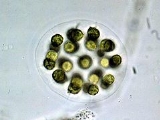
Eudorina
Encyclopedia
In taxonomy
, Eudorina is a genus of colonial green algae
, specifically of the Volvocaceae
. Eudorina colonies consist of 32 individual cells grouped together. Each individual cell contains flagella which allow the colony to move as a whole when the individual cells beat their flagella together. Description by GM Smith (1920, p 95):
Eudorina may be confused with young colonies of Pleodorina, which are very similar (Smith, 1920, p 97.)
Alpha taxonomy
Alpha taxonomy is the discipline concerned with finding, describing and naming species of living or fossil organisms. This field is supported by institutions holding collections of these organisms, with relevant data, carefully curated: such institutes include natural history museums, herbaria and...
, Eudorina is a genus of colonial green algae
Algae
Algae are a large and diverse group of simple, typically autotrophic organisms, ranging from unicellular to multicellular forms, such as the giant kelps that grow to 65 meters in length. They are photosynthetic like plants, and "simple" because their tissues are not organized into the many...
, specifically of the Volvocaceae
Volvocaceae
The Volvocaceae are a family of unicellular or colonial biflagellates, including the typical genus Volvox. The family was named by Ehrenberg in 1834, and is known in older classifications as the Volvocidae.- Description :...
. Eudorina colonies consist of 32 individual cells grouped together. Each individual cell contains flagella which allow the colony to move as a whole when the individual cells beat their flagella together. Description by GM Smith (1920, p 95):
Eudorina Ehrenberg 1832.
Colonies always motile, spherical or slightly elongate, of 16-32-64 cells lying some distance from one another and arranged to form a hollow sphere near the periphery of the homogeneous, hyaline, gelatinous envelope. Cells spherical, with or without a beak at the point of origin of the two cilia. Cilia parallel while passing through the colonial envelope and then widely divergent. Chloroplast single, cupshaped, filling practically the whole cell and generally with several pyrenoids. Cells with a firm wall, one or two anterior contractile vacuoles, and a single conspicuous eyespot near the base of the cilia.
Asexual reproduction by a simultaneous division of all cells to form autocolonies which are liberated by a rupture of the colonial envelope.
Sexual reproduction heterogamous, dioecious, with all cells of a colony developing into large immobile oospheres or plate-like masses of 32-64 fusiform antherozoids; or monoecious with four cells forming antherozoids and the remainder oospheres. Zygote smooth-walled.
Eudorina may be confused with young colonies of Pleodorina, which are very similar (Smith, 1920, p 97.)
External links
- Eudorina - Description with pictures

